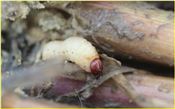Entomologist Group Receives Grant To Study Rice Insect Management
V. TODD MILLER
BATON ROUGE, LOUISIANA
The National Institute of Food and Agriculture (NIFA) recently awarded a grant of more than $295,000 for a multi-year, collaborative project of rice entomologists at three universities to study insect management in furrow-irrigated rice.
The study, led by the LSU AgCenter and pest expert Blake Wilson, along with colleagues at the University of Arkansas and Mississippi State University, are examining the impacts of emerging insect threats in furrow-irrigated rice – or row rice. Wilson says pests that damage paddy rice are different from those that affect row rice.
“The key pest of paddy rice, the rice water weevil, requires a standing flood for infestation,” he said. “Other pests normally deterred by flooded conditions, like the rice billbug, will likely be worse in row rice.”
The development of row rice has rapidly expanded over the past few years, accounting for approximately 10 percent of production in the Mid-south region of the U.S. in 2020. Wilson says this expansion has led to the need to adapt widely used pest management solutions.
The advantages of furrow irrigation over more traditional flood irrigation are:
• Crop rotation flexibility, which allows for crop decisions to be made at spring planting.
• Levee reduction, which facilitates crop rotation and increases land availability.
• Use of ground equipment, reducing the need for aerial applications.
• Production of rice on sloped fields.
• Water usage can be reduced by 10 to 40 percent, relative to flood irrigation.
Currently, the prevalence and impact of row rice insects like the billbug are unknown. The NIFA funding seeks to fill in the gaps through commercial field surveys and research station experiments, like those conducted at the LSU AgCenter H. Rouse Caffey Rice Research Station near Crowley.
Wilson says there are three research objectives for the collaborative study:
• Examine the pest complex attacking rice under different furrow irrigation systems across the Mid-south region.
• Assess economic returns on insecticidal seed treatments under variable furrow irrigation systems.
• Develop a research-based guide to optimize seed treatment decisions for furrow-irrigated rice.
Even with scant current findings to go on, Wilson says the emerging billbug threat has led to yield losses of greater than 10 percent in some documented cases. He hopes the funded research will assist growers looking to prevent yield losses in their row rice crops.
“This project aims to conduct surveys in furrow-irrigated rice across the three states to document insect pest abundance and determine what insects will require management,” he said. “It also aims to identify if and when growers will benefit from the use of insecticidal seed treatments, which are widely used in paddy rice for rice water weevil control.” ∆
V. TODD MILLER: LSU AGCenter

Billbug (Sphenophorus pertinax) infestation has led to yield losses of furrow-irrigated rice – or row rice greater than
10 percent in some documented cases. Billbug larva is pictured.
Photo by Blake Wilson/LSU AgCenter